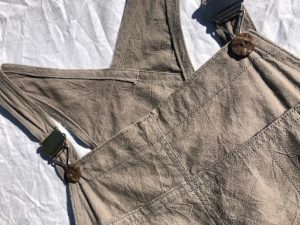Most of us will find brambles in their local area or creeping into their gardens and enjoy their harvest as fresh or cooked fruit – or as the basis for wines and liquers. As a dye material they are best described as fugitive – meaning the colour will fade quickly. However, with careful mordanting it is possible to achieve some lovely subtle shades of pinks and light purples, especially on protein fibres such as wool. The process outlined below can be used for any type of berry including Ivy, Elderberry and Sloe.


The Colour extracted from brambles can look very vibrant in the pan but will likely fade or rinse out to much paler colour.

Right to left: bramble, alder cone and bramble + alder.

Section of a shirt dyed with brambles and partially dipped in iron water.
Collecting your berries –
When looking for fruits to pick you can overlook berries in their prime and instead pick the ones that look less appetising – you’ll find they give plenty of colour.
I have successfully used different methods to extract colour from blackberries.
Ice Extraction.
This is a useful method if you’ve collected your berries over time and have stored them in the freezer.
Step 1.
Weigh your frozen blackberries and use equal amounts of fruit to cloth or fibre.
Step 2.
Place your berries in a heat-proof bowl or pan. Then pour on boiling water to generously cover the fruit.
Step 3.
Stir well and leave the fruit to soak overnight.
Step 4.
Carefully strain the fruit through a gauze lined sieve into a clean pan. Squeezing to extract all the liquid.
Step 5.
Add more water to the dye bath. This should be cold if dyeing wool but hot water can be added for cellulose based fibres like cotton or linen. You need enough liquid to enable your fibres to move freely in the pan.
Step 6.
You can now choose to leave the fibre to soak for at least 24 hours or a few days if possible. You can also choose to apply heat to speed up the process. If using wool, then slowly raise the temperature from cold, to a gentle simmer and maintain for approximately 30 mins. You can add cellulose fibres to a hot dye bath and simmer for an hour. Remove when you are happy with the colour. You can immediately rinse or allow the samples to dry and ‘cure’ for a few days before rinsing.
Hot Extraction
Step 1.
As with the Ice method – weigh your frozen blackberries and use equal amounts of fruit to cloth or fibre.
Step 2.
Place your berries in a pan and pour on hot or cold water to generously cover the fruit.
Step 3.
Apply heat and gently simmer for 30 – 45 mins. Then turn off heat and allow the fruit to steep overnight.
Then follow from step 4 in the previous method
Dyeing with other parts of the plant –
It is also possible to extract colour from bramble canes and leaves which can give a range of mustards and dull yellows. These colours can be modified with iron to give a range of greys and beiges.

Sample dyed in bramble cane

Dungarees made from cloth dyed with bramble cane and dipped in iron.